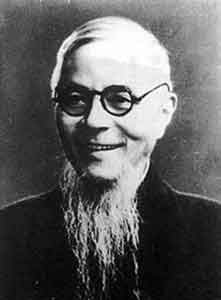

Feng Zikai
CN
267
Artworks
1898 - 1975
Lifespan
Artist Biography
Feng Zikai (November 9, 1898 – September 15, 1975) was a seminal Chinese artist, writer, and educator whose multifaceted career significantly shaped 20th-century Chinese culture. Born in Shimenwan, Zhejiang Province, during a period of profound societal and political upheaval, Feng's life spanned the fall of the Qing Dynasty, the tumultuous Republican era, the Second Sino-Japanese War, and the rise of the People's Republic of China, including the Cultural Revolution. His work, particularly his pioneering *manhua* (comics/cartoons) and essays, provides a poignant commentary on the intersection of these historical shifts with the everyday lives of ordinary people, often imbued with a deep sense of humanism and Buddhist philosophy.
Feng's artistic journey began in his youth, nurtured by an early fascination with illustrations despite his family's more traditional expectations. A pivotal moment in his education was his time at Zhejiang First Normal School (now Hangzhou High School), where he studied under Li Shutong (later Master Hong Yi), a renowned artist and Buddhist monk. Li introduced Feng to Western sketching techniques and, crucially, instilled in him the belief that artistic skill must be intertwined with moral character. This principle became a cornerstone of Feng's artistic philosophy. In 1921, Feng briefly studied in Tokyo, where he encountered the work of Japanese artists like Takehisa Yumeji and further developed his unique style, blending traditional Chinese ink painting with modern sensibilities and a focus on expressive simplicity.
Upon returning to China, Feng became a prolific artist and influential figure in Shanghai's intellectual circles. He is widely regarded as a father of modern Chinese *manhua*. His cartoons, often characterized by their gentle humor, warmth, and keen observation of human nature, especially the innocence of children, gained immense popularity through publications like *Wenxue Zhoubao* (Literature Weekly), where his series "Zikai Manhua" debuted in 1925. The term *manhua* itself gained prominence due to his work. He also worked extensively with the Kaiming Book Company as an editor and illustrator, using his art to disseminate humanitarian values and aesthetic thought, particularly to young readers. His style was accessible, often featuring simple lines and evocative captions, making complex social and philosophical ideas understandable to a broad audience.
The cataclysm of the Second Sino-Japanese War deeply affected Feng. He became a refugee, losing his home, Yuanyuan Hall. During this period, his art took on a more somber tone, depicting the tragedies of war and the suffering of common people, yet always maintaining a compassionate perspective, avoiding the dehumanization of the enemy. A monumental work, the multi-volume "Paintings for the Preservation of Life" (護生畫集), begun in 1928 as a tribute to his teacher Li Shutong and continued over decades, reflects his profound Buddhist beliefs and commitment to compassion for all living beings. This series, often created in collaboration or with the encouragement of Buddhist figures, became one of his most enduring legacies, with volumes completed even under dire circumstances.
After the founding of the People's Republic of China in 1949, Feng's career navigated complex political tides. While initially holding prominent positions in artistic and literary circles, such as council member of the Chinese Artists’ Association and president of the Shanghai Academy of Chinese Painting, he faced scrutiny and pressure during periods like the Great Leap Forward and the Cultural Revolution. Despite attempts at "re-education," he largely maintained his personal beliefs, turning to translation of Russian and Japanese literature as a means of intellectual expression when his artistic output was constrained. He translated significant works like "The Tale of Genji." Even in difficult times, he secretly continued working on "Paintings for the Preservation of Life." Premier Zhou Enlai's appreciation for his earlier work offered some protection and led to a compilation of his cartoons.
Feng Zikai's legacy is profound and multifaceted. He passed away from lung cancer in 1975, but his influence endures through his vast body of work, which includes thousands of *manhua*, essays, translations, and calligraphic pieces. His philosophical contributions, particularly the concept of the "childlike heart" (童心) derived from Mencius and Buddhist thought, emphasize the importance of innocence, empathy, and a pure perspective in understanding the world and fostering compassion. The Feng Zikai Chinese Children's Picture Book Award, established in his honor, underscores his lasting impact on children's literature and art. His ability to capture the essence of human experience with simplicity, warmth, and profound insight ensures his place as one of China's most beloved and influential modern artists, whose works continue to resonate widely.